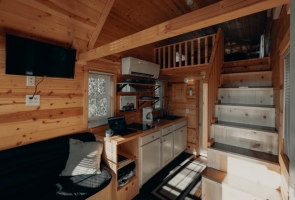We all know how powerful a tool social media is for marketing, but many marketers tend to center their efforts toward online transactions. The truth is, the various social media channels are perfect for initiating and increasing offline brand engagement, too. This is no less true for professionals like you who work in various areas of real estate.
Knowing that it is, in fact, possible to increase open house attendances with social media, the only lingering question should be: “How?” Today, I’m going to answer that question by way of six specific ways you can use real estate social media content to make yourself or your agency more visible and engage with more people in real time. I know you’re already busy, so let’s just get right into it…
1. Link Out to Squeeze Pages in Your Blog Posts
The easiest way to establish and nurture engagement on social media is by posting unique content. One of the easiest forms of content to produce regularly is blog posts. Whenever you post content from your own blog, make a point of telling people to click to read in the caption line of your social media post. Then, somewhere near the end of the post (the very end works even better), add a call to action to click through for more information about your business or to “access more great content like this.”
You can then link to a squeeze page that captures the visitor’s email before presenting the actual content they clicked to see. Don’t be intrusive about it, and don’t bar the gate. Make it possible to click past. This is a good way of weeding out casual observers and capturing emails from serious potential buyers or renters. The point is to get the user used to interacting with your brand someplace other than social media. The more times you can get them to leave Facebook to engage with your content, the easier it will become to get them off the couch for an open house.
2. Use Targeted Ads
Having a solid email list that can be segmented is a great tool and social media can definitely provide those resources. A faster way to reach a good number of people at once, however, involves spending a little money on targeted ads. Facebook, in particular, offers a massive audience that can be tapped for as little as a dollar a day.
Facebook’s demographics are also very pointed and allow distributing messaging to an audience within a very small radius. The other platforms are rapidly catching up, but Facebook is still by far the best and will put your brand in front of the largest possible audience. However, don’t be afraid to tap the capabilities of other more visually centric platforms, like Instagram and Pinterest. Much of the motivation to look at a property is found in pictures, so use your social media time (and dollars) wisely.
3. Create Multiple Business Pages
As a free alternative to paid ads, you can also set up multiple pages that serve specific areas where you do business. Facebook also makes this easy to set up, but using relevant keywords that attract local traffic to your content is always recommended.
I strongly recommend researching your keywords for social media and checking long-tail keywords for optimization before publishing content on pages designated for specific geographic areas. If you don’t, you might get plenty of traffic but none from places where you have properties to sell or rent. I also urge you to understand the terms of service on each individual platform since some have more conservative policies about this type of branding than others.
4. Join Local Groups
Most towns have specific pages where residents gather to discuss all kinds of topics. If your business is located in or does significant business in specific towns, join those pages and engage frequently. Don’t just show up when you have a property to unload. Be present. Make some friends. Let people become familiar with you and your company name.
Most importantly: engage, don’t advertise. Social media is about relationships. The fact that relationship building can lead to sales is a secondary objective on social media. Even though all of them have well-established ad programs, most platforms will flag content that is geared more toward sales than engagement. They want to create an atmosphere for interaction, not sales pitches, which is why even ads on social media are presented in a way that encourages discussion.
5. Join Chamber of Commerce Groups
This one only works if you are already a member of a local chamber, of course, but I’m mentioning it here because many businesses don’t think about the fact that the local chamber has a social media presence. Some don’t, but the vast majority do. That being the case, you should be using that resource to introduce yourself or your agency to other page members.
Most chamber pages are also open to the public, so don’t worry about the exclusive B2B aspect of engaging on a chamber’s social page. There are plenty of prospects to be found, and the group admins are often a little less strict about sales content than average. Do bear in mind, though, that the platforms have their rules, too, and those rules do supersede what page admins will tolerate. Keep your content (and how you present it) friendly to all the powers-that-be.
6. Respond Quickly to Inquires
This one applies most directly to your own business page, but it is an important one to remember. The faster you respond to user inquiries, the more likely you are to gain people’s trust. Facebook keeps track of how long it takes businesses to respond to messages.
You want your rating measured in minutes whenever possible. If it isn’t, shoot for something within a few hours. Once you get into “days” territory, two things happen: People stop engaging, and the platform stops distributing your content at a profitable rate.
We hope that using all the above information to your advantage will help attract more interest in your business and get more people out to open houses. If you’re still struggling, contact us. Our experienced team of real estate content marketing professionals can help spot problem areas in your content and deliver high-quality work that will help boost SEO, social media engagement, and conversions.




